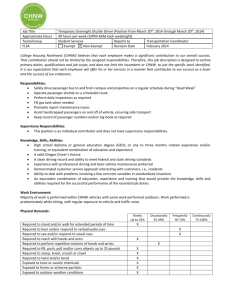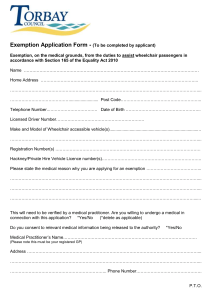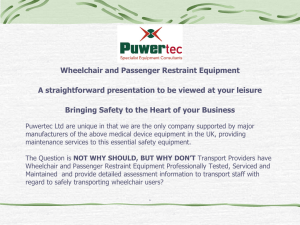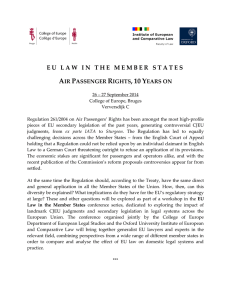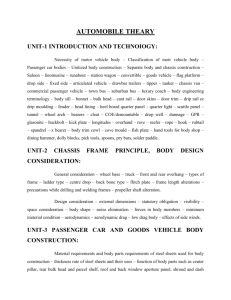Wheelchair Accessible Taxi
advertisement
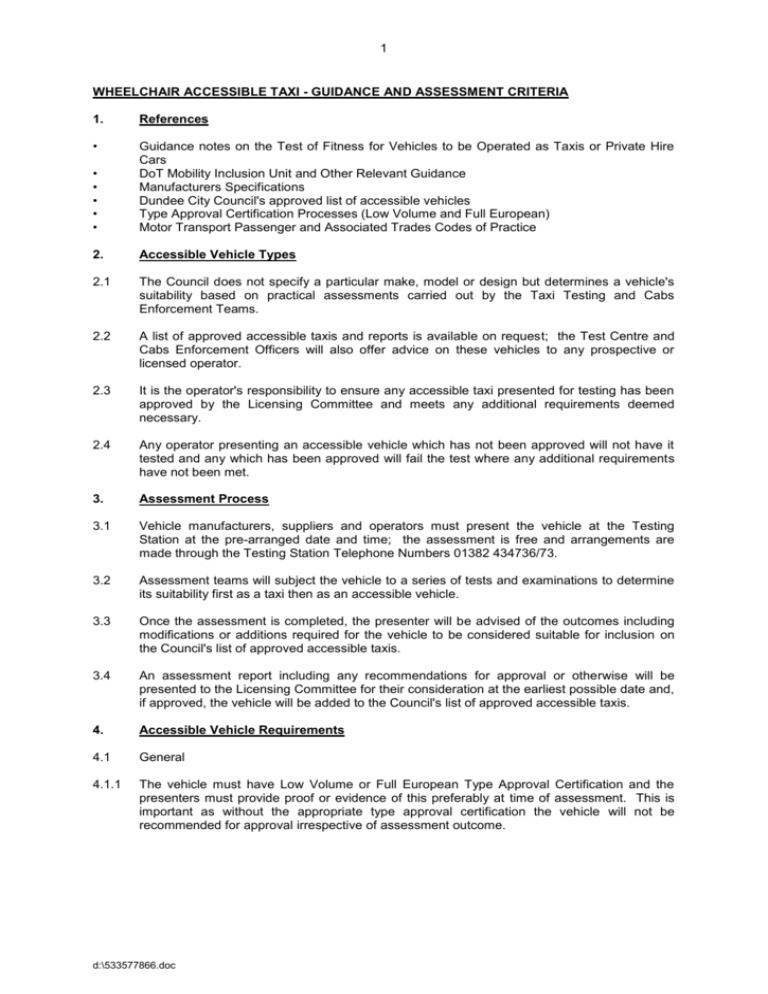
1 WHEELCHAIR ACCESSIBLE TAXI - GUIDANCE AND ASSESSMENT CRITERIA 1. References • • • • • • Guidance notes on the Test of Fitness for Vehicles to be Operated as Taxis or Private Hire Cars DoT Mobility Inclusion Unit and Other Relevant Guidance Manufacturers Specifications Dundee City Council's approved list of accessible vehicles Type Approval Certification Processes (Low Volume and Full European) Motor Transport Passenger and Associated Trades Codes of Practice 2. Accessible Vehicle Types 2.1 The Council does not specify a particular make, model or design but determines a vehicle's suitability based on practical assessments carried out by the Taxi Testing and Cabs Enforcement Teams. 2.2 A list of approved accessible taxis and reports is available on request; the Test Centre and Cabs Enforcement Officers will also offer advice on these vehicles to any prospective or licensed operator. 2.3 It is the operator's responsibility to ensure any accessible taxi presented for testing has been approved by the Licensing Committee and meets any additional requirements deemed necessary. 2.4 Any operator presenting an accessible vehicle which has not been approved will not have it tested and any which has been approved will fail the test where any additional requirements have not been met. 3. Assessment Process 3.1 Vehicle manufacturers, suppliers and operators must present the vehicle at the Testing Station at the pre-arranged date and time; the assessment is free and arrangements are made through the Testing Station Telephone Numbers 01382 434736/73. 3.2 Assessment teams will subject the vehicle to a series of tests and examinations to determine its suitability first as a taxi then as an accessible vehicle. 3.3 Once the assessment is completed, the presenter will be advised of the outcomes including modifications or additions required for the vehicle to be considered suitable for inclusion on the Council's list of approved accessible taxis. 3.4 An assessment report including any recommendations for approval or otherwise will be presented to the Licensing Committee for their consideration at the earliest possible date and, if approved, the vehicle will be added to the Council's list of approved accessible taxis. 4. Accessible Vehicle Requirements 4.1 General 4.1.1 The vehicle must have Low Volume or Full European Type Approval Certification and the presenters must provide proof or evidence of this preferably at time of assessment. This is important as without the appropriate type approval certification the vehicle will not be recommended for approval irrespective of assessment outcome. d:\533577866.doc 2 4.1.2 The presenter will be advised of any modifications or additions required for the vehicle to be recommended to the Licensing Committee for approval. This will not hinder the approval process provided the presenter agrees the changes can be made and that if approval is granted any subsequent vehicle presented for testing as a taxi will be modified or equipped to comply with assessment outcomes. 4.1.3 If the presenter is unable to confirm the modifications or changes can be made then no recommendation for approval will be made and this will remain the case until such time as it can be confirmed the vehicle meets the requirements in full. 4.1.4 The assessment process considers a number of factors including the following:- • • • • • • • Passenger seats and seating arrangements Ramps Luggage and other on-board space requirements Wheelchair and wheelchair passenger security Intermediate steps Grab handles Wheelchair passenger access, egress and headroom 4.2 Passenger Seats and Seating Arrangements 4.2.1 No side-on passenger seats permitted; seats must be forward or rearward facing but can be solid, flip up, fold forward, bench or individual but, irrespective of type, must conform to required testing standards. 4.2.2 Seating for up to a maximum of eight passengers is permitted but all passenger seats must be equipped with individual seat belts; the minimum requirements are:- • • forward facing three point inertia reel type rearward facing two point type 4.2.3 With a wheelchair passenger secured in position, the vehicle seating arrangements must allow for at least two other seated passengers one of whom must be seated in the same passenger area as the wheelchair. 4.2.4 Seats which have to be moved or removed to accommodate the wheelchair must be capable of being stored safely on the vehicle and not compromise or impinge on the minimum number of other passenger seating or other taxi space requirements such as luggage space or spare wheel. 4.2.5 If seats have to be removed then the health and safety of both driver and passengers has to be considered and if compromised will require the seat(s) to be permanently removed from the vehicle. This will result in a reduction in the maximum number of licensed passengers the vehicle will be authorised to carry. 4.3 Ramps 4.3.1 Vehicle ramping systems must be designed to accommodate nearside or rear wheelchair passenger access and egress; offside systems are permitted but these are only in addition to the main nearside/rear access and egress requirements. 4.3.2 A full width solid type ramp is preferred but lighter twin extendible ramps are acceptable provided these are rated at safe working load of at least 300kg/ramp and can be adjusted to accommodate different widths of wheelchair. 4.3.3 Ramps, irrespective of type, must be secured to the vehicle in such a manner as to prevent movement when in use; twin ramp securing systems must prevent splaying of the ramps when deployed. 3 4.3.4 Ramps must allow for both kerbside and ground level access and egress with power assistance provided where ramp angles are considered excessive for safe manual handling, 4.4 Luggage and On-board Space 4.4.1 Luggage and other on-board space requirements i.e. spare wheel, ramp storage and passenger comfort must not be compromised in order to accommodate a wheelchair bound passenger. 4.5 Wheelchair and Wheelchair Passenger Security 4.5.1 Wheelchair securing systems must prevent undue movement of the wheelchair when the vehicle is in transit. Four point securing systems are preferred but other options will be considered provided these do not compromise passenger safety. 4.5.2 Irrespective of wheelchair security device fitted, the system must provide for forward or rearward facing of the wheelchair only; no side-on positioning of the wheelchair is permitted. 4.5.3 Wheelchair passenger belts or alternative securing devices must be adjustable to accommodate a range of passenger requirements, be comfortable when fitted and not constrain arm or head movements. 4.6 Intermediate Steps 4.6.1 A nearside intermediate passenger step may be required where step up heights measured from ground level exceed 350 mm; steps can be fixed, detachable or retractable. 4.6.2 Fixed steps can be external or inboard; if external, the step must not protrude out in such a manner as to pose a hazard to other road users; If inboard, not create a hazard for passengers when the door is closed i.e. any exposed inboard space requirements. 4.6.3 Detachable steps must be capable of being securely stored on the vehicle when not in use and when stored must not compromise passenger safety, hinder passenger access and egress or detract from luggage or any other on-board space requirements. 4.6.4 Retractable steps can be manual, powered or automatic in operation but must have devices fitted to warn the driver or prevent the vehicle moving off with the step deployed. If powered or automatic the steps must have touch sensitive devices or be deployed in such a manner as to prevent anyone standing in close proximity to be injured when the step is deployed. 4.7 Grab Handles 4.7.1 High visibility grab handles, both offside and nearside, will be required at door entrances where it is deemed necessary for assisting passengers on and off the vehicle. 4.7.2 Additional inboard drop down or fixed high visibility grab handles may be required where these directly benefit the safety and security of wheelchair passengers. 4.8 Wheelchair Access, Egress and Headroom 4.8.1 Door entrances dimensions must be sufficient in height and width to allow free and easy movement of a manually assisted wheelchair passenger on and off the vehicle from ground level. 4.8.2 Ramp and vehicle floor surfaces must be flat and free from obstructions so as not to restrict movement and allow easy positioning of the wheelchair passenger when inside the vehicle. Floor seat rails, securing points or depressions must be covered so as not to pose a tripping or trapping hazard for drivers, assistants and other passengers. 4 4.8.3 Door entrances and internal layout must be designed so that seating and other fixings do not impede or restrict the movement of a wheelchair passenger when being positioned in the vehicle. 4.8.4 There must be sufficient headroom available to allow free head movement of a wheelchair passenger when secured in the vehicle and not pose a risk of their head striking the roof when the vehicle is in transit. 4.8.5 Roof mounted fixtures and fittings must be positioned in a manner so as not to pose a risk to any seated passenger whether wheelchair-bound or not. 4.9 Darkened and Tinted Glass 4.9.1 The Council requires vehicles operated as taxis to have clear and unrestricted views into the passenger areas and to meet this requirement clear glass is the preferred option 4.9.2 Where clear glass is not an option on windscreen or driver and front passenger windows, darkened or tinted glass is permitted provided these meet the minimum legal requirements for light transmission. 4.9.3 Darkened or tinted glass is permitted on all other windows provided the clear view requirements are met and the level of tint is no less than the minimum legal requirement for the driver and front passenger windows. 4.10 Model Updates and Modification 4.10.1 To ensure compliance with all requirements all new models of accessible taxi already approved will need to undergo the full assessment and approval process before being added to the Council's list of accessible taxis. 4.10.2 Modifications to models already approved will also need to be presented for assessment but may not need Licensing Committee approval if the assessment team consider the modification too minor in nature. The presenter will be advised of the assessment outcomes and any decisions at the end of the assessment process. 4.10.3 If the assessment team consider the modification major in nature i.e. affects passenger or other road user safety, then the matter will need to be considered by the Licensing Committee and approval given before it can be added to the list. 5 Wheelchair Accessible Taxi Assessment Criteria Summary 5.1 The following DoT Mobility and Inclusion Unit criteria used for guidance purposes only: • • • • • • Swivel Seat Seat height Door width Door height Internal roof height Ramp Angle/Gradient • • • • • • • • • • Intermediate step height Floor area (unobstructed) Grab Rails Door closure effort Door Closure reach Door handle design Door handle length Door handle diameter Door handle clearance Ambient Light Level (Inside) Powered 430mm to 460mm 850mm 1595mm 1625mm maximum 7 degrees/1:12 gradient for 1000mm length of ramp 100mm 1300mm x 1340mm Where appropriate 70N or less 450mm maximum Full wrap power grip 65mm minimum 30mm to 50mm 45mm minimum 150 lux 5 5.2 Other Assessment Criteria • • • • Type approval certification Passenger seating capacity Passenger seats + wheelchair Seats • Removable seats • Seat belts • • • • Ramp type Ramp rating (All types) Ramp width (Single full width) Ramp Widths (Twin) • Floor space for wheelchair • • Intermediate step requirement Intermediate step type • • Spare wheel Luggage space • Luggage space security • • • Windows Taxi Plate Taxi Sign Full European M1 or Low Volume 4 minimum to 8 maximum 2 minimum; 1 in wheelchair area Individual or bench type (16" per passenger); Forward or rearward facing; fixed or removable Flip up, tilting or adjustable (height, fore & aft) Must be stored on vehicle; health and safety considerations for driver and passengers Inertia reel (forward or facing seats); 2 point minimum for rearward facing and centre forward facing bench seat. Fixed or removable 300kg SWL minimum 600mm minimum Adjustable for widths 400mm to 600mm (Adult and Juvenile wheelchairs) Free from obstructions and tripping hazards; seat floor runner grooves and wheelchair securing points covered 350mm or more ground to floor step up height Rear nearside passenger door fitment (external or internal) Detachable, fixed or extending, manual, automatic or powered. Pressure sensitive safety devices Step deployment warning devices External or internal fitting One adult sized wheelchair folded minimum plus space for any on-board equipment storage Guarding or other devices to provide separation and prevent movement of small items entering passenger areas Clear glass or 70% light transmission if tinted External fitting (245mm x 180mm) External fitting (integral or removable)
